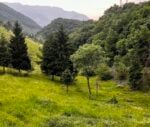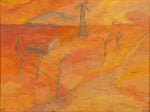Gianfranco Baruchello – Il giardino della mente
 (478x480).jpg)
Il pensiero che guida la mano di Baruchello (Livorno 1924) – un artista ed un intellettuale estremamente colto, profondo e complesso – disegna una spirale rapida e lentissima, semplice e vertiginosa.
Comunicato stampa
La De Primi Fine Art di Lugano è lieta di annunciare la mostra di Gianfranco Baruchello, Il giardino della mente.
Il pensiero che guida la mano di Baruchello (Livorno 1924) - un artista ed un intellettuale estremamente colto, profondo e complesso - disegna una spirale rapida e lentissima, semplice e vertiginosa. Un pensiero che circoscrive una vastissima visione artistica, insieme sperimentale, poliedrica, sociale e politica, che spazia dall’opera aperta di Marcel Duchamp e di John Cage alla video arte, dall’universo concettuale alle ultime prospettive della Land Art. In questa ampia prospettiva, non possiamo considerare questi suoi oli su tela, e i suoi smalti su alluminio o su cartone, le sue tecniche miste e i suoi collage, come opere isolate, autoreferenziali, ma come le tessere di un mosaico artistico molto vasto. Su superfici sempre bianche, vediamo scorrere e dialogare segni, tracce, disegni, geroglifici, punti cosmogonici, in una visione che ancora una volta rivela il frammento come unità e l’unità come frammento: la centralità come dispersione e la periferia come centro. Poiché nulla si sa, tutto si immagina.
De Primi Fine Art in Lugano is pleased to announce the exhibition by Gianfranco Baruchello, The garden of the mind.
Baruchello (Livorno 1924) is an artist and an intellectual highly educated, thoughtful and multifaceted. The thought leading his hand draws a rapid and slow spiral, which is at the same time simple and dizzying. A thought that circumscribes a vast artistic vision that is simultaneously experimental, multifaceted, social and political, which ranges from the open work by Marcel Duchamp and John Cage to the video art and the conceptual universe of the latest perspectives offered by the Land Art. In this broad perspective, we cannot consider his oils on canvas, his enamels on aluminium or on cardboard, his mixed media and his collages, as isolated self-referential works, but should be interpreted as the pieces of a vast artistic mosaic. We see signs, drafts, drawings, hieroglyphics and cosmogonic points, dialoguing together on white surfaces in a vision that reveals the fragment as a unit and the unit as a fragment: the centrality as the dispersion and the periphery as the centre. Since nothing is known, everything is imagined.



